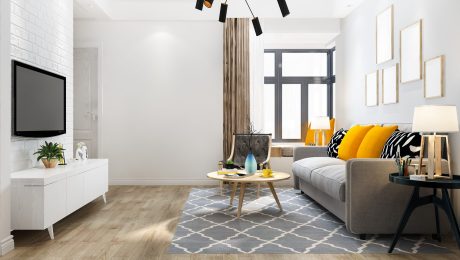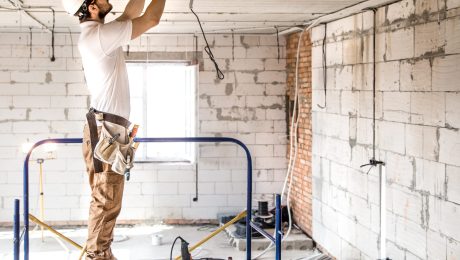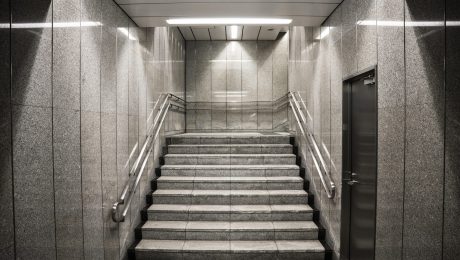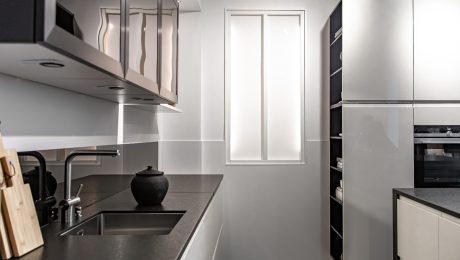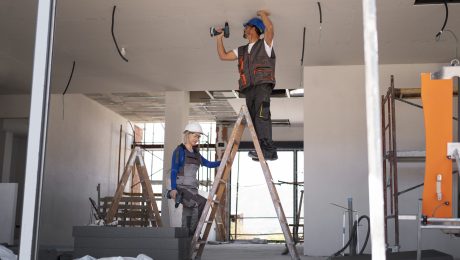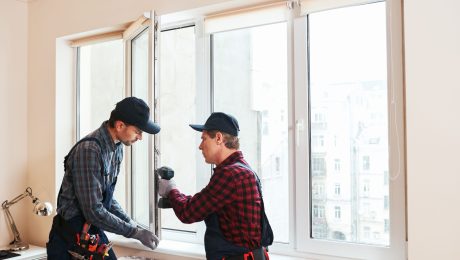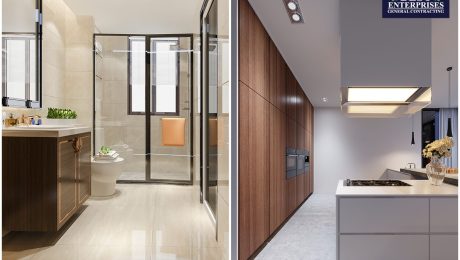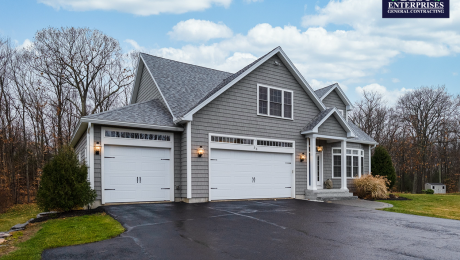How to Renovate Your Home for Better Air Quality
Cleaning the air in your home is critical to your health and overall quality of life. If you’re planning a home improvement project, make sure to renovate your home for air quality by incorporating air purifiers and other indoor air improvement solutions. During and after renovations, using a high-quality air purifier can drastically reduce contaminants like dust, allergens, and VOCs.
In this guide, you’ll discover why indoor air quality should be a renovation priority and how to use the right techniques and tools like home air purifiers to ensure your family breathes clean, healthy air during and after your remodeling project.
Benefits of Renovating for Better Air Quality
1. Health Benefits
Clear air help one avoid respiratory diseases, allergies and ongoing sicknesses. Living in a healthy environment means making sure that when you are designing your home that you take air quality into consideration when renovating.
2. Improved Comfort
The absence of stink, dust and allergens in the house is always a plus especially to the house occupants. Clean air also helps sleep and productivity to improve significantly, which are conditions that make any improvement in students’ health crucial.
3. Energy Efficiency
Some facets of air quality like proper ventilation and air filtration can boost your home efficiency and hence more saving.
Renovation Tips to Enhance Air Quality with a Home Air Purifier
1. Choose Low-VOC and Non-Toxic Materials
Many paints, adhesives, and flooring materials release VOCs, which can linger in your home and harm your air quality. Opt for low-VOC or VOC-free options during your home renovation.
2. Upgrade to the Best Air Purifiers
While renovating, invest in the best home air purifier to trap airborne particles like dust, pollen, and mold. These devices are especially useful during and after construction work.
3. Install an Advanced Air Filtration System
Consider installing a whole-home air filtration system for home. These systems work alongside your HVAC system to filter out impurities across all rooms, maintaining consistent air quality throughout your living space.
4. Enhance Ventilation
Improper ventilation can trap pollutants indoors. Work with a home remodel contractor to ensure your renovation includes features like energy-efficient windows and exhaust fans that improve air circulation.
How to Use a Home Air Purifier During Renovations
1. Select the Right Room Air Purifier
When choosing a home air purifier, consider the room size and the type of pollutants you’re targeting. When redesigning your home try and select paint that is low in VOC or even VOC-free.
2. Position Strategically
During the home remodeling process, purchase a good home air purifier to capture dust, pollen, and mold among other airborne particles. These devices are especially useful in and after constructions projects.
3. Regular Maintenance
In addition to the above suggestions, propose that the home shall install a whole home air filtration system. These systems complement your HVAC system to remove impurities in air throughout each room and give a standard quality of air indoors.
Best Air Purifiers for Renovated Homes
Here are some of the best air purifiers that work exceptionally well during and after home renovations:
- HEPA Air Purifiers: They come with a very important quality of trapping 99.97% of airborne particles such as dust and other allergens.
- Activated Carbon Filters: Really great in neutralizing odor and VOC contained in newly installed materials.
- UV-C Purifiers: These assists to neutralize bacteria and virus making it a safer practice in case there are outbreaks in the community.
Some important things to look particularly at while choosing the right home air purifiers are the size of the space to be covered, the level of noise produced by the purifier and the regularity of cleaning of the purifier.
Key Features to Look for in a Home Air Purifier
- Filtration System
Broad air filtering should be implemented by multi-stage furnaces using HEPA and activated carbon filters. - Energy Efficiency
Choose models certified by the ENERGY STAR logo to decrease the electricity consumption and maintain the purity of the air in your house. - Smart Controls
Top of the range air purifiers have interactive features like mobile application control, ability to monitor atmospheric elements within the room, and capacity to adjust itself depending on the prevailing atmospheric conditions within the room to be cleaned.
Long-Term Renovation Strategies for Clean Air
1. Incorporate Greenery
Meaning, plants are portable air cleaners. Buy new furniture and arrangements to make it a safe place and bring works of indoor plants that purify toxins as a part of the remodel.
2. Use Smart Ventilation Systems
Modern ventilation systems can control the flow of fresh air into any room, remove damp air and lower its level. These systems should be used in conjunction with an air filtration system for home to get the best results out of it.
3. Seal Gaps and Leaks
They can develop gaps in the walls and floor through which outdoor contaminants may infiltrate a house. Caulking windows, doors and walls when you are retrofitting your building can improve the effectiveness of your air purifiers and filtration systems.
4. Partnering with a Home Remodel Contractor
A skilled home remodel contractor can help implement air quality improvements during your renovation. Their expertise ensures that upgrades like ventilation systems, insulation, and air filtration are installed properly and efficiently.
Post-Renovation Maintenance Tips for Air Quality
- Continue Using the Best Home Air Purifiers
Also, when doing a room makeover or redecorating, continue the use of air cleaners because clean air is still important. - Regular Cleaning
Construction dust and debris poses a great challenge when carrying out renovations. Lead cleaning services to clean the floors walls and furniture to ensure that no particle is left behind. - Inspect Ventilation Systems
It is recommended to have your systems of ventilation and heating/cooling periodically checked and cleaned.
Why Air Quality Should Be a Priority
Renovating with this objective is not simply an aesthetic improvement of the house, but a detailed improvement of the house in terms of health. In fact, whether it is changing ventilation systems to the best large room air purifiers, or whether it is opting for low VOCs materials, such changes might go a long way in improving the living environment.
Hence it will help you understand how to make your home not only attractive but also more comfortable with clean fresh air as indicated above tips and strategies.
- Published in Blog, Remodeling
5 Basement Remodeling Ideas for 2025
People do not seem to use basements as poorly illuminated, unfunctional areas of their houses any more. Basement remodeling in 2025 is another trend predominant which converts these areas to functional, fashionable and appreciable add-on to your home. It can turn into entertainment facilities, quiet places for natural living, all you can imagine. Regardless of whether you need a large amount of space after the redesign, or you are simply looking for minor changes, the reconstruction of the basement is complex, but very useful when it comes to increasing the value of your property with the appropriate requirements for the needs of your family. It is possible to have a perfect basement remodel by implementing new styles, and by hiring qualified contractors. Now let’s look into five most popular basement renovation ideas for 2025 to help you get inspired for your basement project as well as learn how a right basement contractor would help you in creating your dream basement.
Create a Luxurious Home Theater
Think about turning your basement into a dramatic home theater. That is why one of the most popular basement remodel ideas in 2025 is a focused movie-watching area.
Key Features for Your Basement Home Theater:
- Acoustic Panels: These improve sound quality while at the same time reducing sound that is transferred to other sections of the home.
- Recliner Seating: Comfortable seating options create a cozy theater-like experience.
- Smart Lighting: Movie nights are made for with dimmer switches and smart lights.
- Large Screen & Surround Sound: Invest in high-quality audiovisual equipment for an immersive experience.
When hiring a basement general contractor, he will be able to install soundproofing and electrical systems – two requirements for a basement.
Design a Modern Home Office
With the advancement in technologies and due to the outbreak of COVID-19 pandemics remote work is now a trend, now transforming your basement into a fashionable and effective, home office is the right decision. When designing basement interior design for home offices it is important to consider comfort, functionality, and also aesthetics.
Tips for a Productive Basement Office:
- Ergonomic Furniture: Choose a desk and chair that support long hours of work.
- Ample Lighting: Switch on artificial light, make use of LED lights or natural light to well illuminate the space.
- Storage Solutions: Use bookshelves or cabinets to store your things in order to have clean and clutter free working area.
- Decorative Touches: It is still possible to add some elements as photographs or painting, green plants, a brightly colored wall, etc. Hiring a contractor for basement remodel will help in finding the best design that fits the functionality of the office as well as the aesthetic value.
Consulting a contractor for basement remodel ensures that your office space is both functional and visually appealing.
Build a Wellness Retreat
Bring the health vibe in your bedroom into your basement and aroma therapeutic oasis for your body. It is indeed among the most striking basement renovations for the homeowner who wants a quiet environment.
Ideas for a Wellness-Focused Basement:
- Home Gym: Provide your home with exercise equipment, a yoga mat, and dumbbells.
- Spa Zone: Try having selected home additions such as a sauna or a hot tub that provides the best relaxation.
- Calming Design: This area should be painted in neutral colours, softly lit and decorated in natural fabrics.
- Sound System: Integrate speakers to play some kind of soothing music or even walking.
Partnering with a basement remodel contractor can ensure proper ventilation and moisture control, critical for gym or spa setups.
Create a Multi-Functional Living Space
If you have families that require additional accommodation, then, there is no better way of making productive use of the basement than getting it converted into a living space. It is quite a kind that allows fulfilling various tasks, including a guest room, a children’s room, or studio.
Features to Include in Multi-Functional Spaces:
- Open Layout: Don’t over-clutter the interior and divide it into the chill zone, the dining area and the play area.
- Convertible Furniture: We recommend folding sofas, or Murphy beds that can be easily converted.
- Storage Solutions: Overhead storage trims the space above a bed, desk, or couch into built-in shelves or cabinets.
- Basement Design Ideas: For instance, you may decide to change your kitchen by adding elements such as exposed brick walls or modern lighting, or more elegantly designed floors.
It is important that an experienced basement contractor guide you through this thrilling change to accommodate your family.
Install a High-End Wine Cellar
Wine lovers regard a custom wine cellar as one of the best enhancements one can make in a basement. This trend is slowly developing the popularity amongst the homeowners wanting to display their collections and at the same time, making the room refined.
Essentials for a Wine Cellar:
- Climate Control: Arrange for proper cooling equipment that will help maintain the correct temperature, humidity, etc.
- Custom Racks: Here, you should target shelving for your collection and for the basement decor that is available.
- Tasting Area: Include an area for people to sit with a table in order to drink wine with friends.
- Elegant Lighting: Accent lighting should be used to illuminate your collection as well as to serve purposes of creating ambiance.
A proficient basement general contractor can deal with some of the intricate issues common to wine cellar construction including insulation and heating/cooling system.
Planning Your Basement Renovation
Why Work with a Contractor for Basement Remodel?
It is important to hire a basement remodel contractor because your remodeling process will be well done and in the right manner. They come with knowledge in such service delivery facets as waterproofing, structural alterations, and construction.
Steps to Begin Your Renovation:
- Assess Your Needs: Categorize the functional use of the space as to how you want it occupied.
- Set a Budget: Find out how much money you can afford to spend, when planning for the undertaking.
- Find Inspiration: Explore basement renovation ideas and trends.
- Hire a Professional: Look for a reputable basement contractor to guide the process.
Best Practices for Basement Renovations
1. Focus on Waterproofing
Every renovation needs a dry basement and here it is!” In addition, it is important that the floors should be well sealed, to avoid cases of water damages such as soaking in the presence of water, or lack of proper drainage and dehumidification.
2. Prioritize Lighting
Basement habitats may be rather damp and temperature fluctuation may be relatively high. Popular choices include vinyl flooring for the floors along with treated lumber as well as mold resistant dry walling.
3. Choose Durable Materials
Fixed shelf systems optimize storage and do not clutter the area with furniture.
4. Incorporate Storage
Built-in storage solutions maximize space and keep the area clutter-free.
Why Basement Renovations Add Value
Basement remodeling provides added value to one’s home by improving its usability and raising return on investment. Due to the motivations of customers, vague finish in the basements is an important aspect as many people are inclined towards having extra living areas. From entertainment zones to private retreats, basement renovations can bring the best if done properly.
Final Thoughts
If you are picturing a comfortable home cinema, efficient working space, or a sophisticated wine storage, these options for basement remodel in 2025 will give the ideas to everyone. Consequently, teaming with a professional and skilled basement remodel contractor guarantees the dream turns into reality and fabulous creation. Begin your project right now and make your basement into the space you’ll enjoy for many years. If you want to start, get a professional basement contractor to help and lead you throughout the renovation process!
- Published in Blog, Remodeling
Top Basement Remodeling Tips and Design Ideas for 2025
Basements are no longer dark, neglected spaces. With the right approach, they can transform into stunning, functional areas. If you’re planning a basement remodeling in 2025, you’ll want to consider the latest trends and practical design ideas. Thoughtful basement renovations can add significant value to your home while enhancing your living space. Whether you’re working with professionals or going the DIY route, this guide provides the essential tips, tricks, and inspiration for modern basement remodeling. From selecting the right finishes to choosing trusted basement contractors, we’ve got everything you need to turn your basement into a showstopper.
Key Considerations Before Starting Basement Remodeling
1. Plan Your Layout
Every successful basement renovation begins with a solid plan. Think about how you want to use the space. Do you need a cozy family room, a home gym, or a guest suite? The layout should reflect your needs while maximizing the available square footage.
2. Address Structural Issues
Check for moisture, leaks, or cracks before diving into a remodel. A dry, sturdy foundation is essential for a long-lasting basement. Engage basement remodeling contractors to assess your space and suggest solutions for any underlying problems.
3. Budget Wisely
Setting a realistic budget is critical. Include costs for materials, labor, and unexpected expenses. Collaborating with experienced basement finishing contractors can help you estimate and stick to your budget.
Basement Renovation Ideas for 2025
Transform your basement with these trending basement renovation ideas:
1. Create a Multi-Functional Space
Modern basements are designed to serve multiple purposes. Combine a home office with a media room or add a workout area next to a playroom. Flexible furniture and smart layouts make this possible.
2. Focus on Natural Light
Brighten your basement with larger windows or well-placed light wells. Mirrors and light-colored walls can amplify the effect, making your space feel more open and inviting.
3. Add a Wet Bar or Kitchenette
A wet bar or kitchenette is perfect for entertaining. Include a mini-fridge, sink, and stylish cabinetry for a functional yet chic addition to your basement remodeling project.
4. Home Theater Setup
With the rise of streaming, home theaters are a popular choice for basement renovations. Install comfortable seating, surround sound, and a large screen to recreate a cinematic experience.
Basement Design Ideas: Trends for 2025
1. Industrial Chic
Industrial-style basement design ideas are making waves. Exposed brick walls, metal accents, and polished concrete floors create a sleek and modern aesthetic.
2. Cozy Retreats
For those who prefer warmth, consider soft lighting, plush seating, and wooden finishes. A cozy basement can serve as a family room or a reading nook.
3. Minimalist Touches
Simplicity is key in many 2025 designs. Neutral colors, clean lines, and uncluttered layouts create a sophisticated vibe.
4. Smart Home Integration
Incorporate smart home technology. Automated lighting, temperature control, and sound systems elevate your basement remodeling project.
Choosing The Best Basement Remodeling Contractors
Collaborating with skilled professionals ensures high-quality results. Here are some tips for choosing the right basement contractors:
1. Research and Reviews
Look for basement remodeling contractors with excellent reviews and portfolios. Recommendations from friends or family can also guide you to reliable professionals.
2. Clear Communication
Discuss your vision, budget, and timeline with your chosen basement renovation contractors. Clear communication avoids misunderstandings and ensures your expectations are met.
3. Licensing and Insurance
Ensure the contractors are licensed and insured. This protects you from potential liabilities and guarantees adherence to building codes.
Transform Your Basement with Expert Finishing Contractors
Experienced basement finishing contractors can make all the difference. They specialize in converting unfinished basements into livable areas. Here are some tips for working with them:
- Discuss Finishes: Choose flooring, wall treatments, and ceilings that suit your style and budget.
- Optimize Storage: Built-in shelving or under-stairs storage can add functionality without taking up extra space.
- Energy Efficiency: Ask about insulation and energy-saving options to make your basement more comfortable and cost-effective.
Choosing Basement Renovation Contractors: What to Look For
1. Expertise
Not all contractors are equal. Look for those with specific experience in basement renovations to ensure a seamless process.
2. Portfolio
Request to see their previous projects. This gives you an idea of their style and craftsmanship.
3. Transparency
Reputable contractors provide detailed estimates and timelines. They should be upfront about potential challenges and solutions.
Basement Design Ideas to Inspire Your 2025 Remodel
1. Open Concept Layouts
An open-concept basement feels spacious and airy. Combine areas like a lounge, bar, and game room for a cohesive design.
2. Statement Lighting
Modern lighting fixtures can transform your basement. Pendant lights, recessed lighting, and LED strips create a stylish and functional ambiance.
3. Bold Colors
While neutrals dominate, bold pops of color in furniture or accent walls can add personality to your space.
4. Unique Flooring Options
From vinyl planks to heated tile floors, innovative flooring materials add both comfort and durability.
Conclusion
Basement remodeling in 2025 offers endless possibilities to transform an underutilized space into something extraordinary. Whether you’re crafting a cozy retreat, a state-of-the-art home theater, or a multi-functional living area, thoughtful design and planning are key. Partner with experienced basement renovation contractors and stay updated with the latest trends to create a basement that enhances your home’s value and functionality. With the right approach, your basement can become the most beloved part of your house.
- Published in Blog
Kitchen Remodeling Mistakes to Avoid: Expert Advice
Renovating a kitchen is always an interesting and challenging process at the same time. It is a capital intensive exercise that if well done can make a big difference in the value and functionality of the home. However, there are some time-tested mistakes that people faced with the work at home idea should be aware of. Below are some tips that a professional in this field can offer so that you can avoid these mistakes when conducting the kitchen remodeling.
Neglecting the Budget
One of the most frequently made errors is, in fact, the absence of a reasonable budget. It is tempting to choose the best brands in kitchen equipment and fancy looks. However, it is important to set one or more limits. Always provide for an emergency fund. Emergencies are bound to happen, especially during remodeling projects.
Ignoring the Workflow
The kitchen is not a living room; it is a workplace. The planning should support this concept. The traditional “triangle rule” is a good starting point. This rule suggests the distance between the sink, stove, and refrigerator should be optimal. Failing to follow this rule might result in a good-looking kitchen that does not serve its intended purposes well.
Overlooking Storage Needs
One of the biggest remorse that homeowners encounter after undertaking a kitchen renovation is lack of sufficient storage space . Make sure that you leave room for many cabinets, draw and pantry. Some ideas of creative arrangements are pull out shelf, lazy Susan, and deep drawer used for storing pots and pans.
Choosing Aesthetics Over Functionality
Yes, you want your kitchen to look good, pretty, whatever, but looks should never take precedence over practicality. For instance, while open shelving is great fashions, it means that you have to work harder at ensuring that it remains neat. Likewise, glossy coatings are certain to give fingerprints and smudges compared to matte ones.
Poor Lighting
This is an essential area that is commonly neglected in most kitchen design when in fact it is important in functionality and also creates the mood. A kitchen should have functional lights which are the task lighting (under-cabinet), the ambient lights (ceiling), and accent lights (pendant or spotlight).
Skimping on Quality
Substandard materials and poor workmanship also have future implications if type of construction is adopted. Use good quality products and contract professional services. This may cost more initially but it would eventually be cheaper as well as would not give a lot of trouble.
Not Considering the Future
You may have a favorite trend that is hot in the design world right now, but your kitchen needs to be timeless. Chose a style that with not be out dated after years from now. Thirdly, you should think about how your need can change in the future. For instance, if your intention is to live in your house when you grow old, then it is time to consider some universal designs.
Forgetting Ventilation
Also for extraction there should be excellent ventilation to help remove cooking smells, smoke, and grease from the kitchen. Ensure you buy a range hood that can address your cooking needs and aims to remove the air outside.
DIY Overconfidence
As we know, sometimes it is all right to do everything on your own, but when it comes to the remodeling of the kitchen it is better to address to the professionals. Many electrical works, plumbing and complex installation jobs have to be done professionally to avoid complications, and ensure compliance to standard safety measures and building regulations.
Lack of Planning
Finally, the biggest mistake is failing to plan adequately. Spend time conceptualizing all aspects of your remodel including location, type of construction, materials, time line and cost. If you want to avoid the costs of changes and schedule extension, you should develop a good plan.
Conclusion
There are many mistakes that homeowners can make during a kitchen remodel, but with some knowledge these mistakes do not have to happen. Ensure that the budget, the flow of works, storage, and print quality takes a priority and do not be shy to ask for help from experts. Happy remodeling!
- Published in Blog, Kitchen, Remodeling
How to Choose the Right Contractor for Your Home Interior Renovation
Choosing the right contractor for your home interior renovation is a crucial step that can make or break your project. A good contractor will ensure that your renovation is completed on time, within budget, and to your satisfaction. Here’s a comprehensive guide to help you choose the right contractor for your home interior renovation.
Define Your Project Scope and Budget
Before you start looking for a contractor, it’s essential to have a clear understanding of what you want to achieve with your renovation. Make a list of all the changes you want to make and prioritize them. This will help you communicate your vision clearly to potential contractors. Additionally, establish a budget for your project. Knowing how much you’re willing to spend will help you narrow down your options and avoid overspending.
Do Your Research
Start by asking friends, family, and neighbors for recommendations. Personal referrals are often the best way to find reliable contractors. You can also search online for contractors in your area and read reviews on websites like Yelp, Google, and Angie’s List. Look for contractors with consistently positive reviews and a good reputation in the community.
Check Credentials and Experience
Once you have a list of potential contractors, check their credentials. Ensure they are licensed, insured, and bonded. Licensing requirements vary by state, so check with your local licensing authority to verify that the contractor’s license is current. Insurance is crucial because it protects you from liability in case of accidents or damage during the renovation. Bonding provides an additional layer of protection, ensuring that the contractor will complete the job as agreed.
Experience is another critical factor. Look for contractors who have been in business for several years and have experience with projects similar to yours. An experienced contractor is more likely to handle unexpected issues effectively and deliver high-quality work.
Interview Multiple Contractors
Don’t settle for the first contractor you find. Interview at least three contractors to compare their qualifications, experience, and pricing. During the interview, ask about their previous projects, how they handle challenges, and their approach to communication. A good contractor should be able to provide references from past clients. Contact these references to ask about their experience working with the contractor, the quality of the work, and whether the project was completed on time and within budget.
Get Detailed Estimates
Ask each contractor for a detailed written estimate that includes the cost of materials, labor, and any other expenses. The estimate should also outline the scope of work, the timeline for completion, and the payment schedule. Be wary of estimates that are significantly lower than others, as this could be a red flag for subpar materials or workmanship. A detailed estimate will help you compare contractors more accurately and avoid misunderstandings later on.
Check for Red Flags
Be on the lookout for red flags that could indicate a problematic contractor. These include:
- Lack of proper licensing or insurance
- Unwillingness to provide references
- High-pressure sales tactics
- Unusually low bids
- Poor communication or unprofessional behavior
Trust your instincts. If something feels off, it’s better to move on and find another contractor.
Review the Contract Carefully
Once you’ve chosen a contractor, review the contract carefully before signing. The contract should include:
- A detailed description of the work to be done
- The total cost and payment schedule
- The timeline for completion
- Warranties for materials and workmanship
- A clause outlining how changes to the project will be handled
Make sure you understand all the terms and conditions. If there’s anything you’re unsure about, ask for clarification. It’s also a good idea to have a lawyer review the contract to ensure your interests are protected.
Maintain Open Communication
Effective communication is key to a successful renovation. Establish a communication plan with your contractor from the start. Decide how often you’ll have progress meetings and the best way to reach each other. Regular updates will help you stay informed about the project’s progress and address any issues promptly.
Monitor the Work
While it’s important to trust your contractor, it’s also essential to stay involved in the project. Visit the site regularly to monitor the work and ensure it’s being done according to the plan. If you notice any issues, address them with the contractor immediately. Keeping a close eye on the project will help you catch problems early and ensure the renovation stays on track.
Be Prepared for the Unexpected
Even with the best planning, unexpected issues can arise during a renovation. Be prepared for delays, cost overruns, and other surprises. Having a contingency fund can help you handle these unexpected expenses without derailing your project. Stay flexible and work with your contractor to find solutions to any problems that come up.
Conclusion
Choosing the right contractor for your home interior renovation is a critical step that requires careful consideration and due diligence. By defining your project scope and budget, doing thorough research, checking credentials, interviewing multiple contractors, getting detailed estimates, and maintaining open communication, you can find a contractor who will deliver high-quality work and make your renovation a success. Remember, the right contractor will not only bring your vision to life but also make the renovation process smooth and stress-free.
- Published in Blog, Remodeling
How to Prepare Your Home for Window Installation
Replacing your windows is one of the best ways to improve your home’s value, comfort, and energy efficiency. To help your installation go smoothly, it’s important to prepare your home in advance. A well-prepared space keeps your belongings safe and helps the crew work faster. Here’s how to get your house ready for window installation.
Clear the Area Before Window Installation
The first measure of planning before putting windows involves a cleanup of the surroundings of each window, both from the interior and exterior view. This will make the installers have full visibility of the windows and no barriers are going to hinder them. Inside the home, relocate every movable object far from the windows, including curtains, blinds and all noticeable decorations. All items that are susceptible to being easily broken should be relocated for the period of the installation, items like vases, picture frames, paintings etc. If window installation is in a room where there could be little space, then bigger furniture can be shifted to another room in the house all together.
In the neighborhood, prune any plant, bush or tree that might hinder one from accessing the windows of their house. You’ll also want to make sure that there is enough room for the installers to put their tools and equipment adjacent to the windows. This encourages efficiency because the installers do their work in a less congested environment and reduces the overall time taken.
Protect Floors and Furniture During Window Installation
Window replacement can be a dirty business. Aspect For example, during the process of removal of old windows or the fixing of new ones, dust, debris and small pieces of the materials may be produced. In order to avoid such incidences and maintain cleanliness within the house, it is important to cover your floors and furniture. Both drop covers, tarpaulin and sheeting for floor coverage with the provision of proper coverage on the interior of the installation area. This protects your floor from scratches, dents, and falling debris during installation. As for items that cannot be removed from the area, use sheets or tarps to cover them so they don’t get dusty or dirty during cleaning.
If the rooms contain carpets where windows are being installed it is wise to use the painter’s tape to stick the edges of the drop cloths on the floors to avoid them from moving when the windows are being installed.
Keep Pets and Children Safe During Installation
Some precautions have to be taken as the window installation process might be dangerous, particularly when young children and pets are present. It is an unfortunate possibility that the installers will be moving around heavy tools, glass, or construction materials, which can be a danger to the pet’s prying eyes or children.
If possible, take your pets elsewhere in the home, or better still, ask someone to keep them elsewhere during the installation process. Plan an activity to keep children in another room and away from the work zone.
This helps to minimize any dangers that may be posed to either those in your family or the installation crew.
Provide Easy Access to Your Home
The workers who will install new windows will be required to work on both sides of the home – the interior and the exterior. Make sure all entrances and exits are clear before the team arrives.
Open all doors and gates to the areas which require the installation of windows. If you have a garage or shed where installers are likely to store materials or equipment, ensure that the location is also readily accessible. Also, see to it that no car is left on your driveway to facilitate easy access of the installation team who should be able to park and offload their items near the working area.
Easy access ensures the crew conducts their work effectively and in return, enables the completion of the project as required.
Remove Window Treatments
These include, curtains, blinds, and shades and will require them to be taken down before the work commences. These items can slow down the installation and may get damaged if left on the walls.
Pull all window treatments off of the windows and set them aside until the other windows are glazed. If you have curtain rods or blinds which use screws to fix them in place, it will be important to remove them too. It also has the advantage of providing the installers with more working space. When you remove window treatments, you simply want to give the windows a chance not only to be safe from being damaged but also to have more free space for other people who work there.
If you are going to apply the same treatments once the new windows are fitted, make sure that every piece of mounting gear is put together in a box or other storage box with the identification so they can just be screwed back when all the fittings are done.
Inform the Installation Team of Any Special Instructions
He usually has certain areas or aspects in his home that may need the attention of the installation team, which is why he discusses this matter with them. Make sure to let the team know if there is anything you are especially worried about when it comes to your home, or any special worries about installation. For instance, most homes are built with subtle features like wooden trims or custom millwork, and it will be wise to brief the installers on these features so that they exercise a lot of caution while working on the area. If you share this information with the crew, they will not cause any accidental damage, and the installation will be done according to the agreed requirements.
Prepare for Noise and Disruption
Windows’ putting is a construction exercise just like any other and therefore could cause so much noise and also interferences. Expect some form of noise because the old window will be taken and replaced by a new one and other tools such as drill and saw are utilized. He recommends that those who work from home or require a quiet setting seek other accommodations during the installation days. Make your neighbors aware of the project, especially if it will require several windows and will take a week or more. This will keep a good line of communication, and they will feel free to tell us when there is going to be noise and hustle-bustle.
Plan for Proper Ventilation
During installation, your old windows will be taken out, and to give you some form of temporary window, the contractor will just make a gap in your walls. This can cause varying temperatures indoors, warm and cooler times of the year, dust, and or insects from outside getting into the home. Proper ventilation is key, especially during extreme temperatures.
Depending on the current weather, you may need to tweak your chosen room’s HVAC for a short time based on comfort. When possible, avoid opening doors to the other parts of the house to reduce the chances of spreading dust or debris around the house.
Conclusion
As you plan for window installation, you don’t have to worry about how to prepare your home for this service. By taking a few steps clearing space, covering furniture, and securing pets you can avoid delays and protect your home. Proper preparation not only guards the home from possible damage but also ensures the installers complete their task as is required faster without compromising their safety. With the right formulation, your new windows will be installed without ever disturbing you and your family, and your home will be comfortable, energy-efficient, and beautiful.
- Published in Windows
The Ultimate Guide for Remodeling of Compact Kitchens
5 Smart Strategies for Budget-Friendly Kitchen Remodeling
Kitchen and Bathroom Renovation: Top Trends and ROI for 2024
As we enter 2024, kitchen and bathroom renovation are among the most popular and valuable trends for home improvement projects. These spaces are evolving beyond mere functionality, becoming personal sanctuaries that reflect homeowners’ desires for style, wellness, and sustainability. Let’s explore the top trends and their potential return on investment (ROI) for 2024.
Kitchen Renovation Trends 2024
1. Smart Technology Integration
The kitchen of 2024 is smarter than ever. Advanced technology is making culinary tasks more streamlined, efficient, and enjoyable. Some key features include:
- AI-driven ovens and refrigerators that can suggest recipes based on available ingredients
- Voice-controlled lighting and faucets for hands-free operation
- Energy-efficient appliances with smart features to optimize energy usage
These innovations enhance convenience and contribute to energy savings, potentially increasing your home’s value.
2. Sustainable and Eco-Friendly Materials
Sustainability is at the forefront of kitchen design in 2024. Homeowners are increasingly opting for materials that have a minimal environmental impact:
- Reclaimed wood for cabinetry and flooring
- Recycled glass countertops
- Low-VOC paints and finishes
- Bamboo or cork flooring options
These eco-friendly choices showcase a commitment to the planet and introduce unique textures and palettes that breathe fresh life into the kitchen space.
3. Multifunctional Kitchen Islands
The kitchen island has evolved from a simple workspace to a multifunctional hub. In 2024, we’re seeing islands that incorporate:
- Storage solutions
- Seating areas
- Cooking zones with built-in appliances
- Charging stations for devices
- Convertible workspaces for home office setups
This trend reflects the growing need for versatile spaces that adapt to various daily activities.
4. Bold Color Choices
While white kitchens have dominated in recent years, 2024 is seeing a shift towards bolder color palettes:
- Two-tone cabinetry, often featuring dark lower cabinets and lighter upper ones
- Statement range hoods in contrasting colors
- Vibrant backsplashes that serve as focal points
- Rich, deep hues like forest green or navy blue for cabinetry
These bold choices add personality and visual interest to the kitchen, making it a more engaging space.
Bathroom Renovation Trends 2024
1. Spa-Like Designs
The bathroom is increasingly being viewed as a personal retreat. Spa-inspired designs are dominating in 2024:
- Freestanding soaking tubs with smart temperature control
- Rain showerheads with customizable water flow
- Steam showers for ultimate relaxation
- Heated floors for comfort
These luxurious features enhance the user experience and can be attractive selling points for potential buyers.
2. Eco-Warrior Fixtures
Water conservation is a key focus in bathroom design for 2024:
- Water-saving faucets and showerheads
- Dual-flush toilets
- Greywater recycling systems
- Solar-powered water heaters
These eco-friendly options reduce water consumption and can significantly save utility bills.
3. Natural and Organic Elements
Bringing nature indoors is a strong trend in bathroom design:
- Stone sinks and countertops
- Wood-look tile flooring
- Living plant walls
- Large windows or skylights to maximize natural light
These elements create a calming, organic atmosphere that promotes relaxation and well-being.
4. Tech-Enhanced Features
Technology is making its way into the bathroom, offering both convenience and luxury:
- Smart mirrors with built-in displays for news, weather, or your schedule
- Touchless, sensor-operated fixtures for improved hygiene
- Chromotherapy lighting systems for mood enhancement
- Digital shower systems with personalized settings
These high-tech features can significantly increase the perceived value of your bathroom.
Return on Investment (ROI) for Kitchen and Bathroom Renovations
When considering a renovation, it’s crucial to understand the potential return on your investment. While exact figures can vary based on location and specific choices, here are some general guidelines:
Kitchen Renovations
- Mid-range Kitchen Remodel: Average Cost: $25,000 to $50,000
- Upscale Kitchen Remodel: Average Cost: $75,000 to $100,000
Bathroom Renovations
- Mid-range Bathroom Remodel: Average Cost: $10,000 to $20,000
- Upscale Bathroom Remodel: Average Cost: $30,000 to $50,000
It’s important to note that while upscale remodels may offer more luxurious features, they often have a lower ROI percentage. This is because there’s a limit to how much value can be added to a home through renovations.
Maximizing Your ROI
To get the most out of your renovation investment:
- Focus on Energy Efficiency: Energy-efficient appliances and fixtures can lower utility costs and appeal to eco-conscious buyers.
- Balance Trends with Timeless Design: While incorporating trendy elements, ensure the overall design has lasting appeal to maximize long-term value.
- Improve Functionality: Enhance the layout and storage options to make the space more user-friendly.
- Consider Universal Design: Incorporate accessible features that appeal to a broader range of potential buyers, increasing your home’s marketability.
- Don’t Over-Improve: Ensure your renovations align with neighborhood standards to avoid pricing your home out of the local market.
Conclusion
Kitchen and bathroom renovations continue to offer substantial returns on investment while allowing homeowners to create personalized, functional spaces. By focusing on energy efficiency, incorporating smart technology, and balancing trendy elements with timeless design, you can create spaces that enhance your daily life and add significant value to your home.
Ready to start your renovation journey? Contact us today to schedule a consultation and transform your kitchen and bathroom into the spaces of your dreams!

